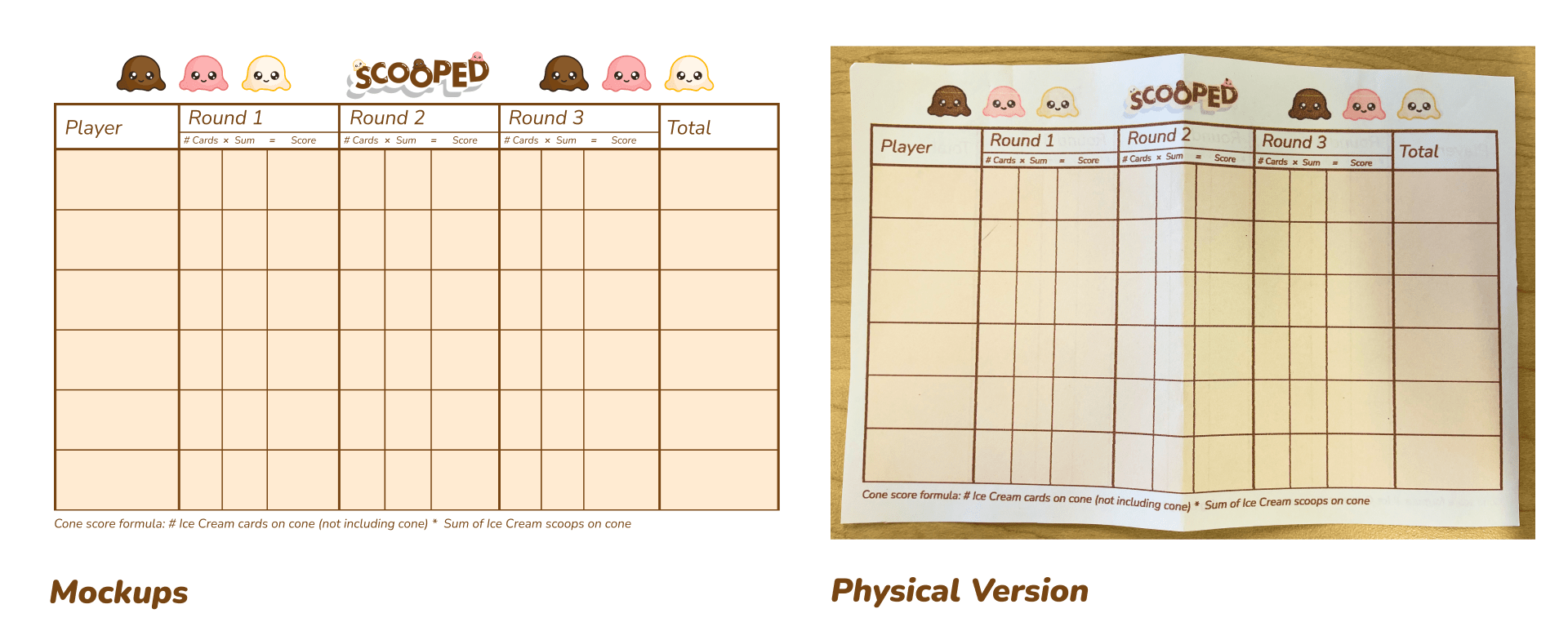Created by Amy Lo, Jin-Hee Lee, Kyle Nguyen, and Michelle Qin
Artist’s Statement
We designed Scooped to spark fun in the spirit of competition and fellowship for groups of friends, family, or strangers. Each player in our game takes on the role of a sweet ice cream parlor, with the goal to build the tallest ice cream cones to outsell their competitors. We intended the game to be easy to play in a casual social setting, and so our manifestation of this idea came through in the form of a card game similar to Uno or Sushi Go!
Additionally, we believe that competition can be a powerful driver of joy in games, which inspired us to implement mechanics that encourage players to strategize and compete with each other. For example, this game includes three novel action cards: attack all other players’ ice cream cones, attack a specific player’s ice cream cones, and protect one’s own ice cream cones. In order to facilitate a sense of fellowship and social interaction, we incorporate a game playing mode that passes hands of cards between players in each round. This was designed with the spontaneity for the individual player and the interactive multiplayer environment in mind.
Ultimately, Scooped is made to spark competition, fellowship, and the desire to be the most successful ice cream shop on the block – all of which we hope inspire the feeling of fun.
Scooped Explained
Concept Map
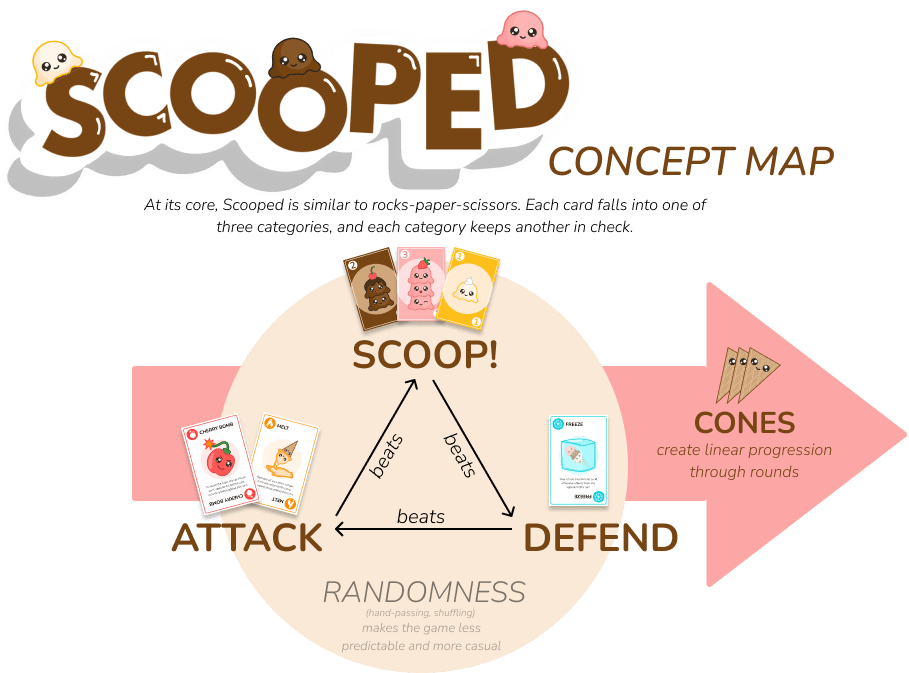
Initial Decisions
From the start, we envisioned making a strategy card game. Some of the fundamentals that we value in a strategy card game and that influenced our design and decision-making include (1) the building of individual property, (2) type of cards (both building cards and attack cards), and (3) method in which cards are drawn.
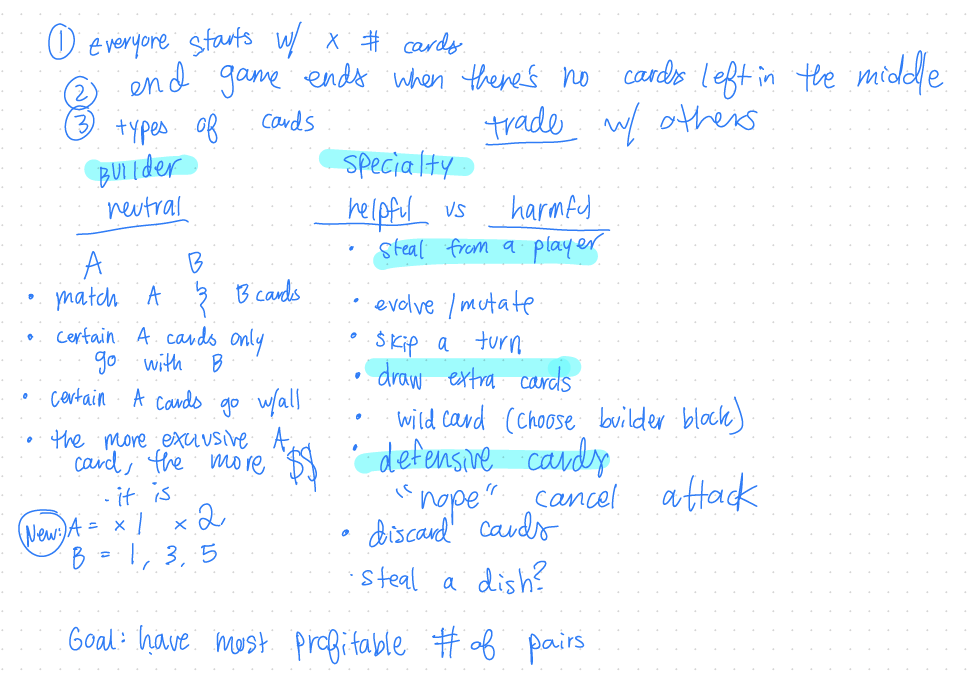
- Building Individual Property: We were inspired by the game Long Cow to think about a card game in which the player’s goal is to construct an item that continues to grow over the course of the game. With food, it was easy for us to imagine how different components can be added together to create a final product, such as scoops being stacked to create an ice cream cone. Thus, the premise of Scooped was born and helped guide our decision-making from thereon.
- Type of Cards: Besides the typical building cards, most strategy games involve special types of cards to attack other players in order to create competition within the game. We experienced several cycles of iterations with creating different types of attack cards, ideating use cases for them, and considering which felt the most natural in Scooped. At the start, our attack cards included abilities to draw 2 cards from the deck, steal a scoop from someone’s ice cream cone, and steal from someone else’s hand of cards. After play-testing and changing the method in which cards are drawn, we discarded those attack cards and replaced them with new ones.
- Method in which Cards are Drawn: Our initial decision was to distribute a hand of cards to each player that they would hold throughout the entire game and add to it by drawing a card from the deck after each turn. After playtesting, we felt that this method was not the most innovative nor fun. We experienced pains with deciding on limits for the number of cards in a hand, lack of fellowship, and tendency to hoard high-value cards and therefore have low-value ice cream cones until the last few rounds when high-value cards were finally played. We ultimately decided to modify the method completely, taking inspiration from Sushi Go to require players to pass hands of cards with each other after each round.
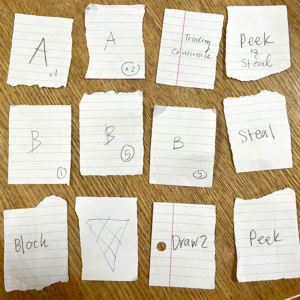
The very first conception of our game looked something like this:
- Players: Because it was easiest to envision a game for our team, we started with a 4-player card game that had every player against every other player.
- Objective & Outcome: The objective for each player is to earn the most points by the end of the game, which means you would have created the most valuable ice cream cones. The outcome of the game comes down to a point score comparison after there are no remaining cards in the deck, leading to one ultimate winner and Nth places depending on score.
- Procedures & Rules: The game used continuous turns: on each turn, a player would be able to play 1 card (i.e. place an ice cream card down) and draw from the center deck to end their turn. The game went around in a circle until there were no cards remaining.
- Resources: A deck of cards, scoresheets, and players.
- Boundaries: Players were inherently bounded by the number of cards in the deck, which ensured a finite play time. Players also felt the social pressure to not take too long to play their turn, so as to respect other players.
Testing and Iteration History
We playtested with multiple different groups, including classmates and teaching staff from CS247G, hallmates from our dorm, and our team. There were at least 9 official playtests conducted with external players (and too many playtests to count that occurred within our team). Each playtest included at least 2-6 unique players who had not played the game before. Below is a brief walkthrough of the significantly different versions of our game:
Matching for Maximum Profit
The initial version of our game was built as a matching game with social aspects to boost your progress and deter others’. Taking inspiration from Long Cow, we had different types of ingredient cards (Ice Cream vs. Topping) that players had to match to build up a valid cone, which they would sell all at once at the end of the game to see how much “profit” they made overall. We also had a similar mechanic to Exploding Kittens in that you drew from the center to end your turn and had various action cards.
- What Worked: winces when stolen from or blocked, smiling at the visual concept of cute ice cream, did not need to consult the rulebook once learned at the beginning.
- What Didn’t Work: lots of sifting through starting hand, unclear how to advance if you have all ice creams and no toppings, low frequency of player reactions, it’s possible to have unplayable cards with cone cards as part of the deck, game too long.
“I wish there was a way to destroy other players for the sake of it. I want to melt down other people’s ice cream!”
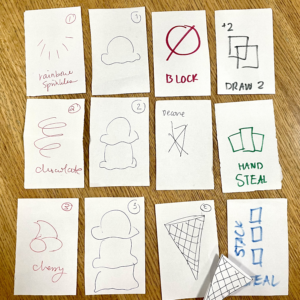
Pass-and-Play with Matching
We decided to act on the feedback we got and make our mechanics more exciting for players. As mentioned above, we incorporated the gameplay mechanic from Sushi Go that had players pass their hand to their right after playing a card. This meant that players no longer drew from a center deck to end their turn, and that game time depended on the size of the starting hand instead of the entire deck. This is the stage at which we set the starting hand size to 5.
- What Worked: groans after, much harder to predict your outcome causing more chaos, refined action cards led to higher frequency of reactions.
- What Didn’t Work: Trying to play a card simultaneously was somewhat uneven, the attack option seems useless with the high number of defense cards in the deck.
“The Melt doesn’t seem powerful if someone else can just block it every time.”
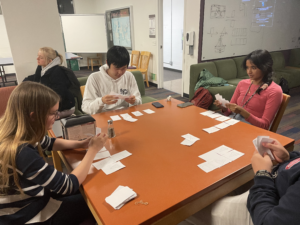
Pass-and-Play with No Matching
We found that players largely ignored the matching with the pass and play, and the toppings made it confusing for them. We decided to respond to this in our next iteration. Rather than matching to sell an ice cream, we moved to just ice cream scoops with different point values to avoid clutter. With the spontaneous passing method, it became too hectic to have to keep track of different kinds of ingredients. We also increased the starting hand to 6 so that the maximum game with 6 players could have a completed circle of hand passes.
- What Worked: much easier to sum the total value of a sold cone.
- What Didn’t Work: hard to find a balance of the starting hand to use for a game that lasts beyond a couple of minutes. People also kept mixing up the Cone cards with the ice cream scoops, which is why ended up changing the Cone cards be cone-shaped so that they wouldn’t shuffle into the deck.
“Wait, why can’t I put down a Cone for my turn?”

Multi-Round Pass-and-Play
Our solution to this was also inspired by Sushi Go, which uses a multi-round system. At the end of each round, you sell a cone; there are 3 rounds and 3 cones, so the game ends after all cones are sold. We found that players enjoyed seeing who was doing well after a given round, which affected their decisions about who to target with attack cards.
- What Worked: strongest reactions yet (laughter, light-hearted offense, big groans) that demonstrated fellowship, more motivation for how to strategize and interact with other players, hope for doing better the next round, clear mark for game end.
- What Didn’t Work: variation on where action cards were played, not as much interaction with a fixed number of action cards based on the number of players.
“Everyone, target [name redacted]! They’re doing the best so far!”

To target the points of confusion from our final playtests, we enhanced our rule sheet by adding diagrams in the “How to Play” section and modified our “Cards” section to describe not only the function of each card, but also how it should physically be played in the game.
Extensions
After finalizing the mechanics of our game, we continued to spitball ideas that could add some spice to the gameplay. However, we went back and forth on these because we didn’t want the game to be too difficult to learn, and we were happy with the mechanics as they were. In order to not let these ideas go to waste, we playtested and created additional ways to play and included them at the end of the rulebook. Players could use the exact same resources with slightly altered rules and procedures if they wanted to add a layer of difficulty to the game after playing a few times or simply try something new!
Extensions include a speed round, a different way of scoring including the ice cream flavors, incorporating uniqueness as part of playability, and switching the direction of the passing between rounds.
Final Playtest Video
Final Prototype
Print to play
- Action Cards
- Cone Cards
- Ice Cream Cards
- Rule Book
- Scorecard (print as many as needed)
Final Mockups vs. Physical Version
Box Design (Front & Back)
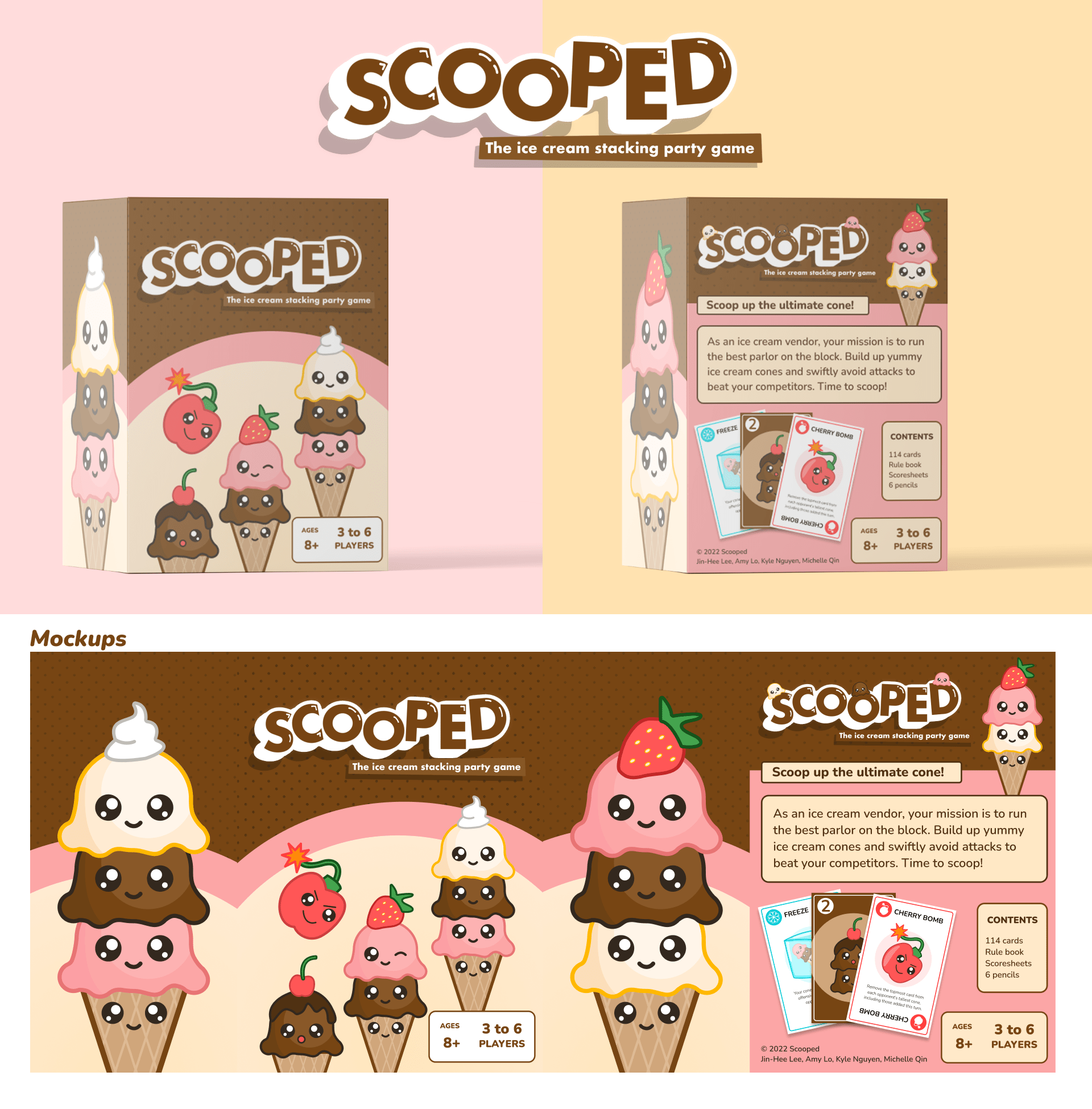
Card Designs
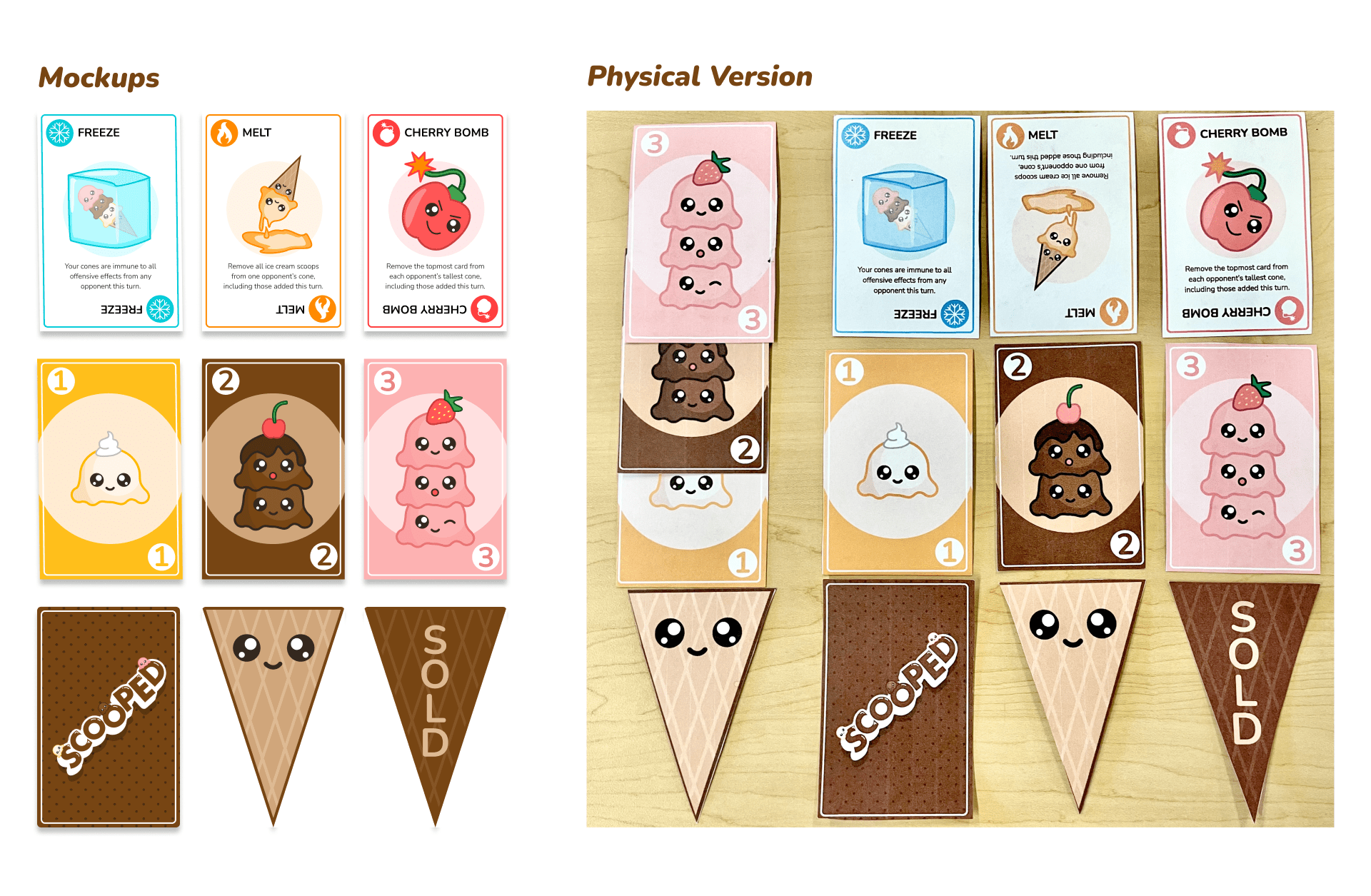
Rule Book
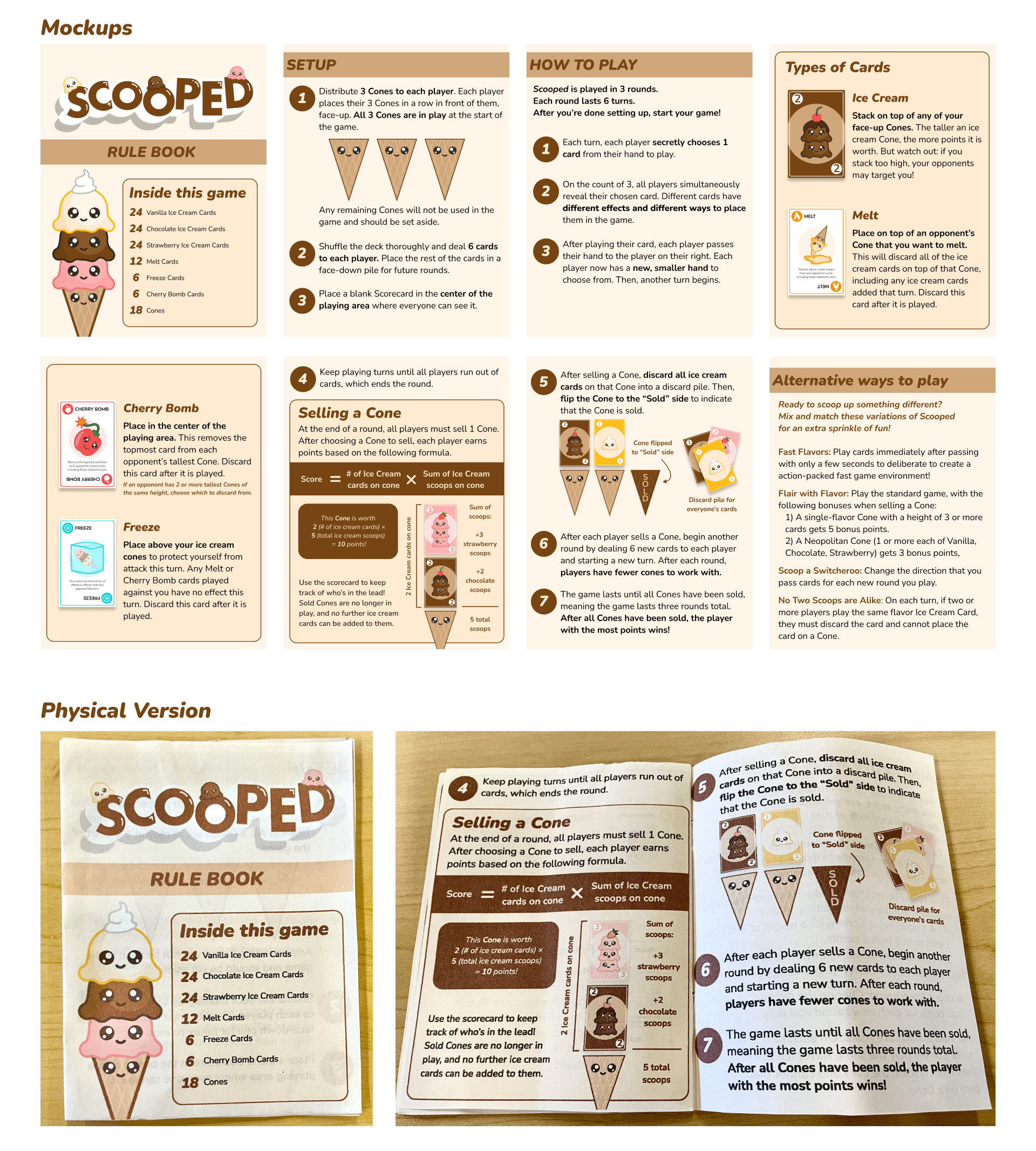
Scorecard
